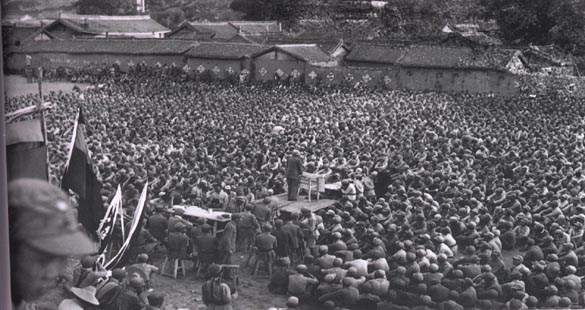CHINA DAILY
 A Communist cadre leader addressing survivors of the Long March in the 1930s PHOTO/Wikimedia Commons
A Communist cadre leader addressing survivors of the Long March in the 1930s PHOTO/Wikimedia Commons
Communist-nationalist alliance breaks up
The Chinese Communist Party had its origins in 1921. The shaky alliance with the Nationalist Party headed by Chiang Kaishek came to a halt on the morning of April 12th, 1927 with a feast of heads. Thousands perished. Some were shot; some beheaded; some hurled alive into the glowing furnaces of steam locomotives. So many heads were chopped off that the weary arms could hardly raise their great scimitars from their sides. What few escaped, including Zhou Enlai fled to the west to Jiangxi Province. The remoteness of Jiangxi was so great in the 1930s that the government had almost no control over this area. Roadless, as was most of China in those years, it was traversed only by mountain footpaths by people carrying bundles on their backs, horse-and-mule caravans, single file, too narrow for even carts, made Jiangxi a haven for rebellion. Everywhere flourished illiteracy, disease, poverty, and ignorance. It was here that Mao Zedong set up his new Soviet Communist zone.
The Soviet Zone in Jiangxi
For seven years the communists prospered despite everything Chiang Kaishek and his Nationalists Koumingtong (KMT) could do in The First, Second, Third, Fourth, and now the Fifth, “annihilation” campaign against the “Red Bandits” as he referred to them. Until the Fifth Campaign, the Communists had played hit-and-run. They sucked the KMT deep into their territory and sandbagged them with deadly ambushes. The Communist captured huge quantities of guns and ammunition and from the thousands of KMT prisoners, they replenished losses in their ranks. Now in the Fifth Campaign, thanks to Hitler who had dispatched one of his best Generals, Hans von Seeckt, to come to China to direct the newest tactics. Von Seeckt moved the KMT troops forward very slowly and then built concrete reinforced blockhouses and pillboxes (some 3,000 in the past year). This allowed the KMT to control every path and road. The noose was being drawn around the Red Army slowly but surely. Now the Red Army was confronting the KMT in costly head to head battles. For Chiang, the end to the Red Bandits was near at hand and he took great comfort in this.
Moscow had sent their German, Otto Braun, to advise the Chinese communist group. The Red Army was now under the leadership of Otto Braun, (Chinese name of Li De) Bo Gu, (a Moscow trained Chinese), and Zhou Enlai. Mao was not in a leadership role and had no say in the operations, military or otherwise. After a year of terrible losses (about 60,000 men), one disastrous battle after another throughout Chiang’s Fifth Campaign, the end was near. As autumn 1933 gave way to winter 1934, the Fifth Campaign chewed into Communist territory. The Soviet Republic contracted again and again. By autumn of 1934, the Communists had lost 58% of their territory. It was decided that the Red Army must leave the area in order to survive. On October 16th, the move began. No one was sure where they were heading, they were just leaving.
The Long March Begins
86,000 men and woman began the trip that would last over a year until October 19, 1935 in Yan’an in Sha’anxi Province. Some of the prominent Chinese leaders that began the Long March were Mao Zedong, Zhou Enlai, Deng Xiaoping, Zhu De, Peng Dehuai, leading the Third Army Group, Lin Biao, leading the First Army Group, Nie Rongzhen, political commissar of the First Front Army, Liu Bocheng, Ye Jianying, (the preceding from Zhu to Ye would later be declared Marshals in 1955), and Li Xiannian, who would become the President of the People’s Republic of China. He Long, (also to be named a Marshal) had been sent ahead leading the Second Army Group and to-be-Marshal Chen Yi was left behind with the wounded and sick.
China Daily for more